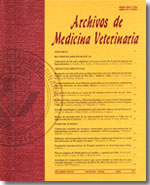Megaesophagus in the dog: a bibliographic review and a new classification proposal
Main Article Content
Abstract
When studying the esophagus in both human beings and animals, the most common pathological finding is a megaesophagus. From a pathological stand point megaesophagus can be defined as an abnormal dilatation which can be partial or total.
The clinical characteristic of this disorder is the regurgitation syndrome due to insufficient esophageal transit, accompanied by nutritional and growth deficiencies, in puppies, with weight loss, nutritional deficiences as well as pulmonary complications due to pneumonia by aspiration in adult dogs.
This pathology has diverse origins which can be classified into two groups:
a) a transit disorder due to an anatomical alteration of the esophageal wall, for example stenosis by scarring, persistence of the aortic arch, tumors, etc.
b) a transit disorder due to functional alteration of the autonomic nervous system.
The present work gives a bibliographic review of the subject, proposes a new classification of the different types of megaesophagus, its etiology, clinical treatment, prognosis, and a working scheme that will aid in the differential diagnosis.
Article Details
How to Cite
TORRES, P. (1997). Megaesophagus in the dog: a bibliographic review and a new classification proposal. Archivos De Medicina Veterinaria, 29(1), 13–23. https://doi.org/10.4067/S0301-732X1997000100002
Issue
Section
REVISIONES BIBLIOGRÁFICAS

